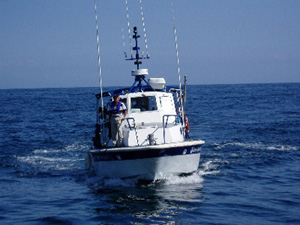|
 |
|
Daily
At-Sea Logs |
| Sunday, May 16, 2004 Greetings from Gray’s Reef. We’ve had a great day here in the sanctuary today. It all started when Greg announced that our focus here in the southeast region of Gray’s Reef is threefold: retrieving the video logger, working with the production crew, and deploying more fish traps. Mark’s video logger was deployed yesterday afternoon to capture video with the four cameras that are attached to its frame. During the retrieval phase, as the ship approached the logger’s buoy, the strong ocean currents forced the ship to cross over the line and consequently cut it. Currents are known to shift often here in Gray’s Reef, in part, because of the fluctuations of the tides. Since we are relatively close to land, approximately 20 miles, tidal action significantly affects the deployment and retrieval of our units, not to mention the control over the boat’s movement. The Global Positioning Satellite (GPS) system has been a great tool for us during this research, and comes in handy today as we search for the logger. Luckily, we have the GPS coordinates of the location where Mark’s video logger was first deployed, as well as the buoy’s position when the line was cut. As a second safety measure, Dr. Daniela Di Iorio attached a “pinger”, a sound-producing device that transmits a pinging sound (as the name implies) to the logger’s frame. Even with these pieces of information, finding the logger will not be an easy job for our divers. Great news! The captain just reported on the intercom that Glenn and Dave (our divers) have located the video logger and reattached it to its buoy. After speaking to Daniela, she confirmed that the “pinger” was a critical tool in finding the logger. She and Mark (the logger’s technician) worked as a team to locate the approximate position of the unit from the boat. Daniela wore headphones that pick up the pinging sound, as Mark held the receiver in the water to direct the pinging into her headphones. If the receiver is pointed in the direction of the logger, then the pinging sound heard by Daniela gets louder. The opposite is true when the receiver is pointed in the opposite direction. Using this tool, allows the crew to hone in on the unit, even though it was many yards away from the position where it was first deployed. This is because the logger was dragged by the ship for some distance before the line was cut. Once the position of the sound’s source was located, the divers were sent in to retrieve the unit. Thanks to Daniela’s pinger and the determination of the ship’s crew, science and dive teams, Mark is a happy camper; or boater, that is. On a side note, isn’t it neat to think about how tides exert so much force over objects, like this big ship for instance? Despite Commander Fred Rossman's attempts to control the position, the ship is still affected by the tides and currents below. As I sit on the deck, watching this struggle between nature and man, it is hard not to feel minute in comparison. It brings me great joy to think about how interconnected everything is here on Earth - the biosphere, hydrosphere, atmosphere and geosphere; even the forces of outer space affect us here on Earth, as we are experiencing here today with the tides.
The second item on our agenda involves deploying fish traps. Throughout the day, between the excitement of the recovering the video loggers, as well as the interviews and film shootings, George’s team deployed and retrieved five traps. With the exception of an octopus, there is nothing unique about today’s catches; we’ve caught a lot of black seabass, scup, and tomtate, as usual. The
sun is setting on our seventh day. I hope you will come back tomorrow
to share with us our adventures in Gray’s Reef. |
|||||||||


 The
boat carrying the Turner South production crew has just arrived for
Day 2. (picture on left) They
will continue to capture additional footage of our research operations
and interview additional team members. Rumor has it that I will be
interviewed to discuss my role on the ship. I’m very excited
that they think my role in this operation is important, too. Education,
as I see it, brings people together and engenders good decision-making.
As our population grows, as well as migration of people to the coastal
areas within the United States, it is important that the general public
is made aware of the incredible resources that exist just off the
mainland, like Gray’s Reef. Most people do not think much about
coastal and ocean environments, therefore, not a lot is being done
to understand or protect these resources. As outreach projects, such
as this one, increase in number and diversity, we hope that people’s
literacy in ocean science will also increase.
The
boat carrying the Turner South production crew has just arrived for
Day 2. (picture on left) They
will continue to capture additional footage of our research operations
and interview additional team members. Rumor has it that I will be
interviewed to discuss my role on the ship. I’m very excited
that they think my role in this operation is important, too. Education,
as I see it, brings people together and engenders good decision-making.
As our population grows, as well as migration of people to the coastal
areas within the United States, it is important that the general public
is made aware of the incredible resources that exist just off the
mainland, like Gray’s Reef. Most people do not think much about
coastal and ocean environments, therefore, not a lot is being done
to understand or protect these resources. As outreach projects, such
as this one, increase in number and diversity, we hope that people’s
literacy in ocean science will also increase.